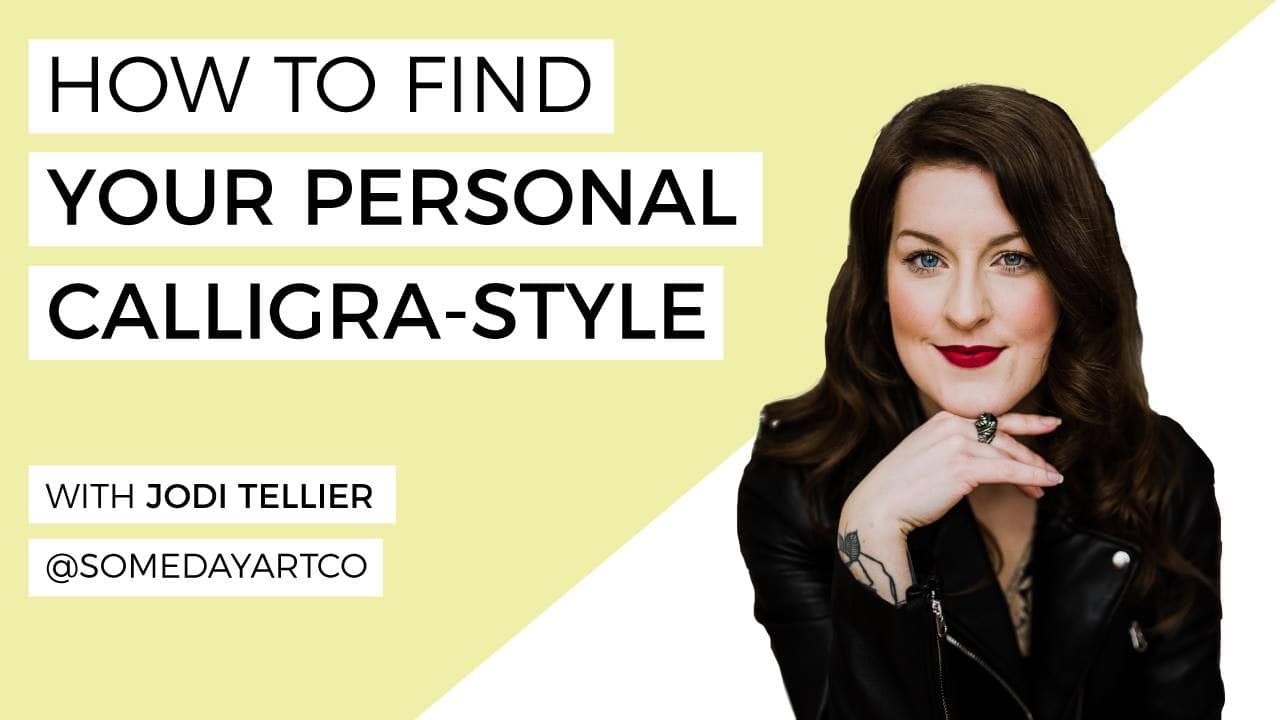One of my most asked questions is “how can I find my own style?”.
So I brought in Jodi Tellier the artist and calligrapher of Someday Art Co. and the brains behind the Find Your Calligraphy Style Masterclass to help us out. (And trust me, with just a quick look at her Insta account you’ll understand why Jodi is sought after by brands and brides for her unique style!)
The links below may be affiliate links where appropriate. This means that your purchase through these links may result in a few cents in payment to me, to support creating further resources like this one! That being said, I will never suggest supplies that I do not personally use and fully recommend.
Now that you’ve watched the video, here’s a quick recap of the 4 things you can do to help find your style.
STEP ONE: PRACTICE
One of Jodi’s favourite lettering exercises is the Alphabet Exercise. Some of you might be familiar with the regular method, where you go through the alphabet and using words that start with each letter of the alphabet following a theme (such as “Friends Quotes” or “Dog Breeds”)
Jodi’s method, however, has taken this practice and turned it into a self-care exercise! What you do is set yourself up in a little bubble of your favourite things and do the exercise using a theme you adore. Your personality will subconsciously inject itself into your practice. As an example, for Jodi that means getting comfy with a big glass of wine, some moody music in the background and Lana Del Rey lyrics as her theme.
A few other things:
- You don’t need to post your work. Practice for YOU and not for the intent that whatever you create needs to be posted.
- Put your phone away. Inspiration is great, but letting your mind practice without the influence of other artists is very beneficial.
- Date your work! It’s important to look back over time and see how your style has evolved and how your work has improved.
“Not everything has to go on Instagram” – Jodi Tellier
STEP TWO: ANALYZE
Practice is all fine and dandy, but you still need to practice with proper technique. By going over your work and analyzing it, you can really determine the parts you need to improve on and take them as an opportunity to insert your unique take.
As an example, Jodi shared how analyzing her work is how she discovered and area that needed improvement, which lead to her using that opportunity to insert her style and created an ombre effect. (Jodi actually shows us the practice sheets from this particular discovery, so check out the video to see for yourself!)
So in short, if there is an aspect of your work that technically isn’t “correct”, there might be a way for you to turn it into a unique part of your style! You’ll only know by actually taking the time to analyze it.
STEP THREE: EXPERIMENT
Experimenting, not just with style but also with tools, is how you will determine what really works for you.
A good way to try this is to push the stylistic limits of a particular letter (exaaaaaagerate things!), and then bring it back down until you land on something that really sits well with you.
STEP FOUR: REPEAT
Basically, you want to keep doing the above 3 steps over and over again.
Your style is ALWAYS changing. Even if you feel like you’ve found your style, you’ve probably evolved naturally over that time, and you will have to go back and analyze again. That’s why repeating these steps is so important!
A good tip that Jodi does, is to revisit your style before any big milestones. For example, go over your work before the new wedding season so that you can have a clear idea of what your upcoming season will look like. How will you letter common words? Will you continue looping certain letters the same way you used to, or does that element not work with your natural evolution?
Now to round it all up…
It is through practice that you develop your skills, it is through analyzing that you will see what you do naturally, it is through experimenting that you can see what works for you and it is by repeating these steps that you will evolve into a unique artist.
Extra Tips:
- Just because it’s a trend, doesn’t mean you have to implement certain styles into your work
- Classic is classic for a reason!
- Having a strong foundation (*cough* the basics strokes *cough*) is really important if you want to evolve naturally
- Set limits for yourself! Limit the amount of accounts you follow, or follow OTHER types of artists. See what else is out there!
Huge thanks to Jodi for sharing her 4 tips on how to find your own style! In the interview, we also covered some of the questions that were submitted to the Happy Ever Crafters Facebook group prior to the interview, so be sure to check out the video!

Comments